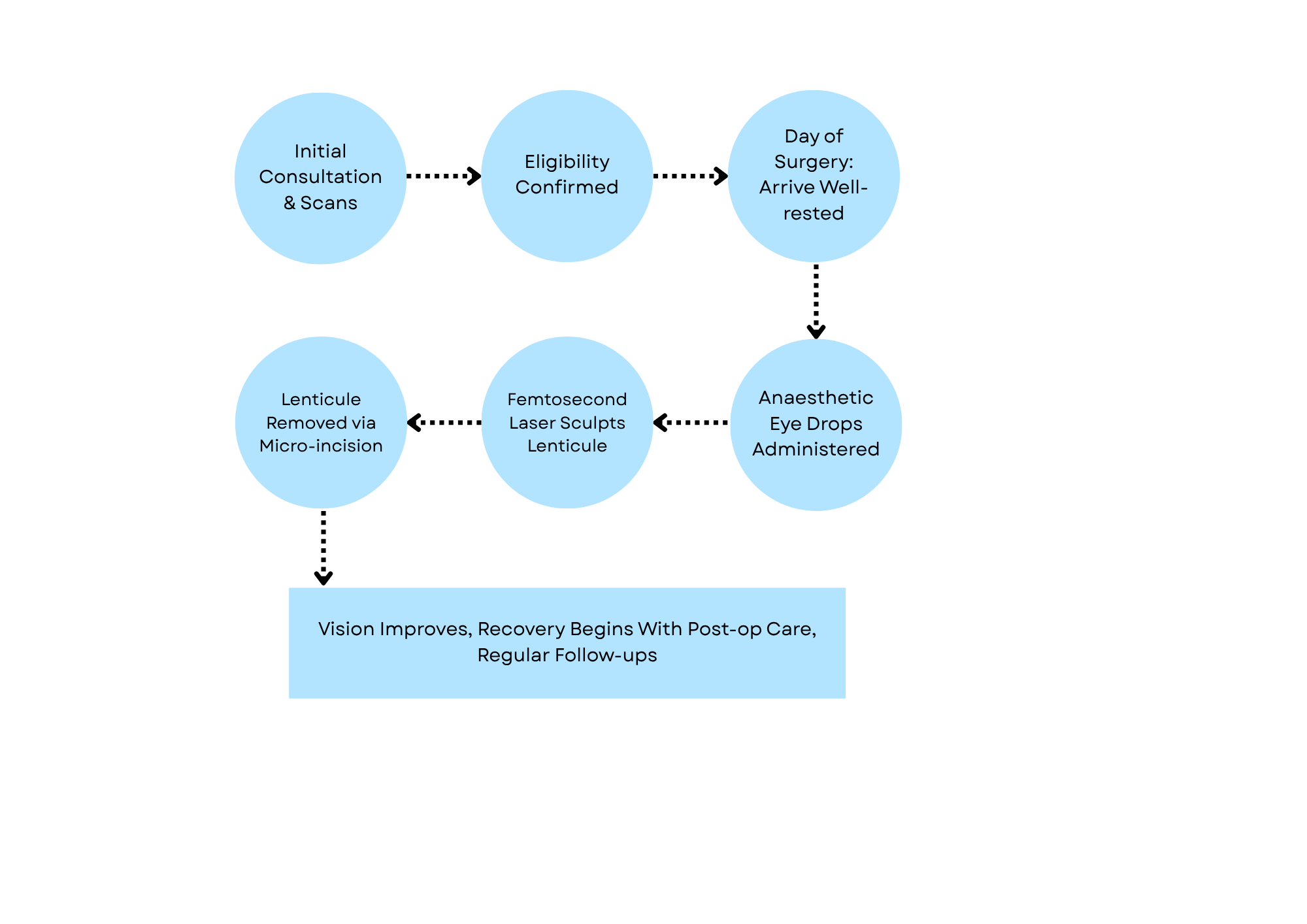In a world that’s constantly in motion, people want vision correction that keeps up. Meet SMILE eye surgery (Small Incision Lenticule Extraction), a minimally invasive, flapless surgery, which stands out not just because it’s new, but because it answers exactly what modern patients are looking for in terms of a quick, low-maintenance procedure. Unlike older procedures that involved more cutting or longer recovery times, SMILE is substantially simpler.
Within the dynamic field of medical innovation, SMILE eye surgery and SMILE vision correction have amassed a fair bit of popularity, particularly in the world of refractive surgery.
Now, the question arises- what truly distinguishes SMILE from the other surgeries? What is innovative about it?
Interested to know more? Dive into it below!
Essence of SMILE Surgery’s Appeal
This innovative surgery, termed as Small Incision Lenticule Extraction, (although, better known as SMILE eye surgery), is a minimally invasive, flapless, bladeless, laser procedure designed to correct short-sightedness (myopia) and certain types of astigmatism. Rather than creating a flap as in LASIK, SMILE relies on a femtosecond laser to sculpt a thin, disc-shaped section (“lenticule”) inside the cornea, which is then gently removed via a micro-incision. This small change to the corneal shape brings light into the right focus on the retina and gives patients the confidence to step into a world that is crisp and clear
Table of Contents
How Does SMILE Vision Correction Work?
If you are considering SMILE vision correction, understanding the journey helps ease any nerves:
[Initial Consultation & Scans]
→ [Eligibility Confirmed]
→ [Day of Surgery: Arrive Well-rested]
→ [Anaesthetic Eye Drops Administered]
→ [Femtosecond Laser Sculpts Lenticule]
→ [Lenticule Removed via Micro-incision]
→ [Vision Improves, Recovery Begins]
→ [Post-op Care, Regular Follow-ups]

- The procedure typically takes about 15 minutes for both eyes.
- There is no use of blades, and stitches are not required.
- Most people go home the same day and start to notice improvements in just hours.
From the moment you walk in for a consultation till the very end, this procedure has made significant advancements, ensuring everything is tailored to provide comfort and confidence.
What Sets SMILE Vision Correction Apart?
Minimally Invasive:
Instead of a large corneal flap, SMILE eye surgery uses a micro-incision just 2-4mm long. This protects more of the eye’s biomechanical strength and causes less disruption to corneal nerves, often resulting in fewer symptoms of post-surgical dry eye
Flapless and Secure:
No flap means no risk of flap displacement during the weeks following the surgery and recovery from it. If you’re active, love to travel often, or simply want one less thing to worry about, this might just be a worthwhile concept for you to explore with your ophthalmologist!
Swift, Simple Recovery:
It’s been reported by many that they have noticed clearer and sharper sight simply within a few hours. Light sensitivity and mild grittiness are normal, but these resolve quickly. Most resume regular routines the day after the procedure, and the aftercare tips are minimal! Sometimes, gentle care and protective drops are all that is needed.
Excellent Precision:
The accuracy and precision delivered by the laser is truly a nod to the advancements in the field of vision correction, and cannot be understated. It is computer-guided, which means the accuracy is within microns. It thus ensures a high degree of predictability and long-term stability, even for patients with moderately thin corneas.
Excellent Safety Record:
Complications are rare. As long as you choose trusted surgeons and hospitals, rest assured that the treatment is safe. Thousands have undergone SMILE vision correction with high patient satisfaction, which is higher than traditional LASIK for many.
When Might SMILE Eye Surgery Not Be Suitable?
As effective as SMILE is, it’s not a one-size-fits-all solution. The first step in the process is always a thorough evaluation. People with severe dry eyes, unusual corneal shapes, who have high astigmatism, or immune conditions that affect healing might not be suitable candidates.
But don’t self-diagnose based on what you read online- let your eye specialist decide what’s best. Sometimes, LASIK or other options may suit you better. Remember, the point is to find the right fit for your eyes, not just for the trend!
SMILE Eye Surgery vs LASIK: Quick Comparison
| Feature | SMILE Eye Surgery | LASIK |
| Flap creation | No | Required |
| Incision type | 2-4mm laser keyhole | ~20mm corneal flap |
| Recovery | 1-2 days (for light, non-strenuous work) | 2-4 days (for light, non-strenuous work) |
| Dry eye risk | Lower (preserves more corneal nerves) | Higher (as compared to SMILE) |
| Suitability | Myopia, mild astigmatism, thin corneas | Broader (including hyperopia) |
Are There Risks or Side Effects?
No surgery is completely without risk, and SMILE is no exception. That said, it ranks among the safest vision correction procedures available today. Minor side effects like glare, mild blurring, or temporary sensitivity to light can happen, but they typically resolve within days or weeks.
What to Expect:
- Mild grittiness, watering, or photophobia is common on the first day.
- Vision is typically good enough to return to a sedentary routine within 24-48 hours.
- Night vision symptoms (glare, halos) are rare but can occur and usually fade within weeks.
Complications:
- Under/overcorrection (rare, enhancement possible via PRK)
- Transient corneal haze/healing issues
- Infection or inflammation (<0.1% at experienced centres)
Post-op Do’s and Don’ts:
- Don’t rub your eyes for at least a week.
- Use prescribed antibiotics and lubricants diligently.
- Avoid swimming, eye makeup, and dusty environments during the first week.
- Wear sunglasses outdoors.
Long-term data:
CFS and peer-reviewed studies show overwhelmingly high patient satisfaction (above 98%), with long-term stability of refraction. Surface sensitivity (for contact lens wearers) is preserved better than with LASIK.
A skilled surgeon from a reputable hospital using trusted equipment makes all the difference. When done right, SMILE has a remarkably low complication rate and a consistently high patient satisfaction score.
Conclusion
In summary, SMILE, a minimally invasive, flapless eye surgery, combines next-generation laser technology with patient-focused design. People are attracted by the promise of lasting results, rapid comfort, robust safety, and a life less dependent on spectacles. When performed at experienced centres, you can trust that every step is guided by scientific rigour, experience, and genuine care.
It’s clean, it’s quick, and it’s designed for people who want lasting results with minimal interruption to their lives. If you’ve been waiting for the “right” moment to ditch the glasses or contacts, this just might be it.
My passion of providing Tech to Gadget lovers with the latest ups & downs happening in the World of Technology and innovation made this blog come true.
